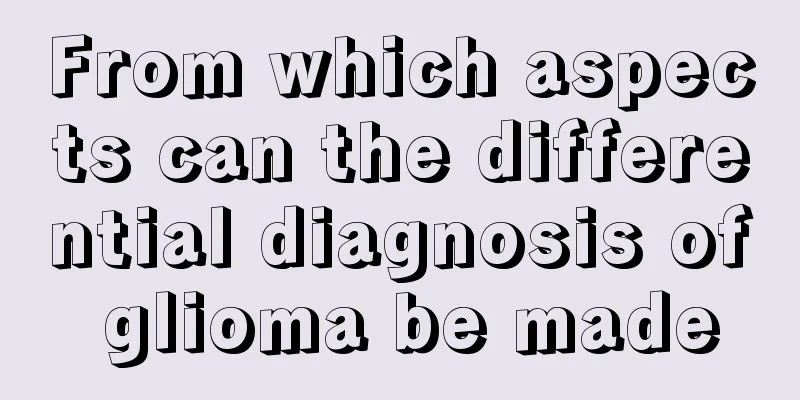From which aspects can the differential diagnosis of glioma be made

|
The diagnosis of glioma can be based on the patient's age, gender, location of occurrence, etc., or it can be based on medical history and neurological examination. In addition, some auxiliary examinations are required to confirm the diagnosis. So, from which aspects can the differential diagnosis of glioma be made? Let me introduce it below. 1. Diagnosis of X-ray Films X-rays have limitations in diagnosis. They can only show the optic nerve foramen, which has certain clinical significance, but are difficult to show the tumor itself. They are rarely used now. B-ultrasound has qualitative diagnostic significance for optic nerve gliomas. It can clearly show the lesions in the orbit, but it is difficult to show the lesions in the canal and the brain. It can be used as a screening examination method. CT can accurately show the location, shape, boundary, orbital and intracranial conditions of the lesions. In particular, it can more clearly show the enlargement of the optic canal and the widening of the distance between the anterior clinoid processes, making it easier to determine the nature and scope of the lesion. However, it is difficult to show smaller gliomas in the optic canal, or to accurately show gliomas of the optic chiasm or optic tract. There is also a certain limit to accurately judging the relationship between the lesion and the adjacent structures. MRI can accurately show the scope of the lesion and its relationship with the adjacent structures, especially for gliomas in the optic canal and the optic chiasm or optic tract, providing a reliable basis for clinical surgery. MRI is the best examination method for this disease, and B-ultrasound and CT can be used as auxiliary examination methods. 2. Imaging differential diagnosis ① Optic nerve meningioma: It is common in adult women and causes visual impairment, mostly behind the exophthalmos. Optic nerve sheath meningioma may be eccentric, with a high CT value, and may be accompanied by spotted, ring-shaped or irregular calcifications. MRI examinations show medium signals on both T1WI and T2WI, and a "track sign" can be seen after CT or MRI enhancement. ②Optic neuritis: Clinically, it manifests as a sharp decrease in vision, which may be accompanied by pain when the eyeballs are turned and deep orbital pain. MRI shows diffuse thickening of the optic nerve, which generally does not form a soft tissue mass. The optic nerve signal on T1WI is reduced, the signal on T2WI is increased, and the signal on STIR is high. It may be enhanced after enhancement. It is best shown by enhanced scanning combined with fat suppression sequence. It may be a change of multiple sclerosis. If MRI shows periventricular sclerotic plaques, this disease can be confirmed. 3. Pathological diagnosis and molecular biological markers It is strongly recommended to strictly follow the WHO (2007) classification of central nervous system tumors for pathological diagnosis and grading of gliomas. In order to cooperate with the treatment, efficacy observation and prognosis judgment of glioma patients, glioma molecular biological markers should be performed as appropriate: the detection of IDH1 gene mutation and chromosome 1p/19q heterozygous loss in low-grade gliomas is of great significance for clinical prognosis judgment (level I evidence). Glioma with astrocyte differentiation characteristics and 60%~70% of oligodendrogliomas are positive for glial fibrillary acid protein (level I evidence). Oligodendrocyte-specific nuclear transcription factors have a certain reference value for distinguishing oligodendrogliomas from gliomas of astrocyte origin. Epidermal growth factor receptor amplification and its variant III mutation are valuable for the diagnosis of primary GBM. Ki-67 proliferation index is closely related to the degree of differentiation, infiltration or metastasis and prognosis of the tumor, and is one of the important reference indicators for judging the prognosis of the tumor (level I evidence). Neuron-specific nuclear protein is of great significance in judging the neuronal components in the tumor, and is mainly used for the diagnosis and differential diagnosis of glial neuron tumors and neuroblastomas. |
<<: Common methods of treating tongue cancer
>>: Women should be more alert to the harm of tongue cancer
Recommend
How long after removing a mole can I wash my face?
After removing a mole, you cannot wash your face ...
How to check rectal polyps?
For many diseases, in addition to symptoms, the m...
How to get rid of armpit hair
Everyone grows armpit hair, but some people have ...
What foods are better for hair loss
Severe hair loss causes great pain to many people...
Brief discussion: What is the key to preventing cervical cancer
Gynecological diseases have always troubled the f...
What is the best way to treat varicose veins and external hemorrhoids
I believe that many people have not heard of vari...
Is it good to sleep with the air conditioner on at night?
Air conditioning can be said to be a must-have fo...
Can green peppers be eaten raw?
Green pepper is a common food in daily life and c...
What is fake rice made of
Some time ago, there was news about fake rice on ...
What are the symptoms of lung cancer lymph node metastasis? Pay attention to these points
The clinical symptoms of lung cancer lymph node m...
Reasons for failure of ovulation induction
In real life, if a couple wants to conceive throu...
Can zinc deficiency cause eczema? There are many causes of eczema
Nowadays, more and more babies are suffering from...
Latex mattress allergy
Modern people pay more and more attention to heal...
Knee joint disease cannot be ignored
It is a common phenomenon that the elderly in the...
What is Lyme disease
When it comes to Lyme disease, everyone may be re...









